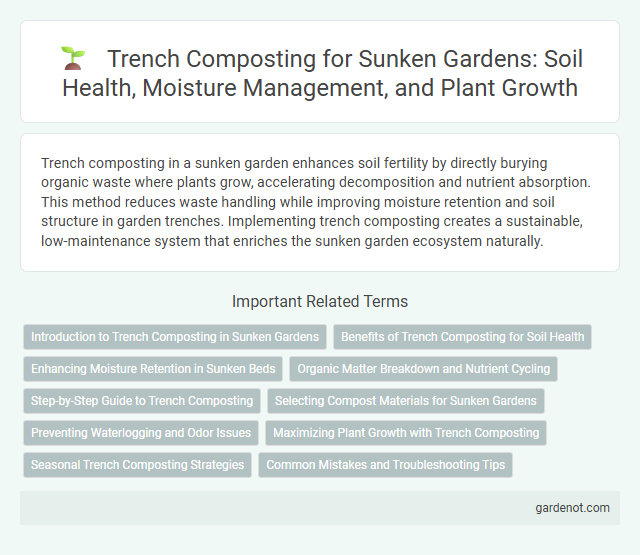Trench composting in a sunken garden enhances soil fertility by directly burying organic waste where plants grow, accelerating decomposition and nutrient absorption. This method reduces waste handling while improving moisture retention and soil structure in garden trenches. Implementing trench composting creates a sustainable, low-maintenance system that enriches the sunken garden ecosystem naturally.
Introduction to Trench Composting in Sunken Gardens
Trench composting in sunken gardens involves digging deep, narrow trenches where organic waste decomposes directly in the soil, enriching it with nutrients. This natural decomposition process enhances soil structure, moisture retention, and microbial activity, promoting healthier plant growth. Sunken gardens benefit from trench composting by reducing waste, improving fertility, and sustaining a balanced ecosystem.
Benefits of Trench Composting for Soil Health
Trench composting enriches soil fertility by directly integrating organic matter into the ground, enhancing microbial activity and nutrient availability. This method improves soil structure, promotes moisture retention, and reduces erosion in sunken garden environments. Benefits also include minimizing surface waste and fostering healthier plant growth through sustained nutrient release.
Enhancing Moisture Retention in Sunken Beds
Trench composting improves moisture retention in sunken garden beds by decomposing organic matter directly within the soil trenches, which increases water-holding capacity and reduces evaporation. The decomposed material enriches the soil, promoting better root absorption and sustaining soil moisture during dry periods. This natural method enhances the microclimate of sunken beds, supporting healthier plant growth and efficient water usage.
Organic Matter Breakdown and Nutrient Cycling
Trench composting accelerates organic matter breakdown by providing an oxygen-limited environment that fosters microbial activity essential for decomposition. This method enhances nutrient cycling by directly returning vital nutrients like nitrogen, phosphorus, and potassium into the soil, improving soil fertility and structure. The sunken garden benefits from reduced surface waste and sustained nutrient availability, promoting healthier plant growth and increased biomass production.
Step-by-Step Guide to Trench Composting
Trench composting in a sunken garden involves digging a narrow trench about 12-18 inches deep to bury organic waste, accelerating decomposition and enriching soil nutrients. Begin by placing kitchen scraps, garden clippings, or shredded leaves in the trench, then cover them with soil to prevent odors and pests. This method enhances soil fertility naturally, improves moisture retention, and supports healthy plant growth by recycling organic matter directly into the garden bed.
Selecting Compost Materials for Sunken Gardens
Selecting compost materials for sunken gardens involves choosing organic matter rich in nitrogen and carbon to promote efficient decomposition. Ideal ingredients include kitchen scraps like vegetable peels, coffee grounds, and garden waste such as leaves and grass clippings, ensuring a balanced nutrient profile. Avoid meat, dairy, and glossy paper to prevent odors and pests, maintaining a healthy compost environment within the sunken garden.
Preventing Waterlogging and Odor Issues
Trench composting in a sunken garden enhances soil fertility by allowing organic waste to decompose underground, preventing surface clutter. Proper trench depth and well-draining soil conditions are essential to avoid waterlogging, which can cause anaerobic decomposition and unpleasant odors. Maintaining adequate soil aeration and layering dry materials within the trench helps control moisture levels and minimize odor problems effectively.
Maximizing Plant Growth with Trench Composting
Trench composting enriches soil by decomposing organic matter directly within planting trenches, improving nutrient availability and soil structure. This method enhances water retention and root penetration, leading to healthier, more vigorous sunken garden plants. Maximizing plant growth through trench composting supports sustainable gardening by reducing waste and promoting natural fertilizer cycles.
Seasonal Trench Composting Strategies
Seasonal trench composting maximizes organic decomposition by aligning buried plant materials with local climate cycles, ensuring optimal microbial activity throughout the year. In spring and summer, fresh kitchen scraps and garden waste are buried in shallow trenches to accelerate breakdown under warm, moist conditions. During fall and winter, deeper trenches with more carbon-rich materials like leaves help maintain soil fertility while minimizing nutrient loss and odor.
Common Mistakes and Troubleshooting Tips
Trench composting in a sunken garden often leads to mistakes such as improper trench depth, which can prevent adequate decomposition and attract pests. Failing to balance green and brown materials results in odors and slow breakdown of organic matter. To troubleshoot, ensure trenches are dug 12-18 inches deep, layer diverse compostable materials evenly, and cover with soil to promote aeration and deter pests effectively.
Trench composting Infographic

 gardenot.com
gardenot.com